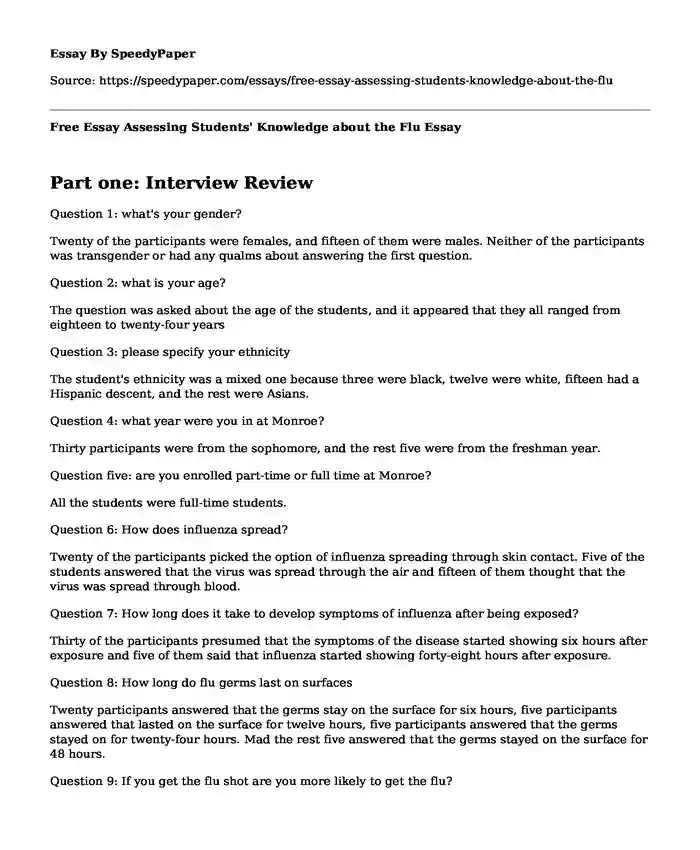
| Type of paper: | Essay |
| Categories: | Community health |
| Pages: | 3 |
| Wordcount: | 687 words |
Part one: Interview Review
Question 1: what's your gender?
Twenty of the participants were females, and fifteen of them were males. Neither of the participants was transgender or had any qualms about answering the first question.
Question 2: what is your age?
The question was asked about the age of the students, and it appeared that they all ranged from eighteen to twenty-four years
Question 3: please specify your ethnicity
The student's ethnicity was a mixed one because three were black, twelve were white, fifteen had a Hispanic descent, and the rest were Asians.
Question 4: what year were you in at Monroe?
Thirty participants were from the sophomore, and the rest five were from the freshman year.
Question five: are you enrolled part-time or full time at Monroe?
All the students were full-time students.
Question 6: How does influenza spread?
Twenty of the participants picked the option of influenza spreading through skin contact. Five of the students answered that the virus was spread through the air and fifteen of them thought that the virus was spread through blood.
Question 7: How long does it take to develop symptoms of influenza after being exposed?
Thirty of the participants presumed that the symptoms of the disease started showing six hours after exposure and five of them said that influenza started showing forty-eight hours after exposure.
Question 8: How long do flu germs last on surfaces
Twenty participants answered that the germs stay on the surface for six hours, five participants answered that lasted on the surface for twelve hours, five participants answered that the germs stayed on for twenty-four hours. Mad the rest five answered that the germs stayed on the surface for 48 hours.
Question 9: If you get the flu shot are you more likely to get the flu?
Thirty of the participants disagreed to the idea that getting flu shots would result in the contraction of the disease. And five agreed to the question
Question 10: Is the flu shot safe for the elderly, children and pregnant women
All of the participants felt that the flu shots were safe for the elderly, children and the pregnant women.
Question 11: What year did the influenza vaccine first become available in the United States?
Eleven participants felt that the vaccine first became available in 1957, ten answered that the shot became available in 1926, three said that the flu shot became available in 1945 and eleven others believed that it became available in 1995.
Question 12: What can you do to prevent the flu?
All the participants felt that washing hands often with a hand sanitizer, covering mouth when sneezing, staying home when infected and getting the flu shot were essential measures in the prevention of the disease.
Question 13: How long are people contagious?
Thirty participants felt that a person was contagious as long as they had symptoms three presumed in two days the germs were not contagious and two of them thought that for a week a person was contagious.
Question 14: How long does it take to fully recover from the flu?
Twenty-nine students felt that in three to five days one should have recovered from the flu entirely and the other six picked one to two days.
Question 15: Can you get influenza more than once?
All the students agreed that it was possible to get the flu more than once.
Part two: Conclusion and Recommendation
The students had relatively fair knowledge about the spread and the contraction of the flu. Most of the answers that are provided have a near accuracy such as the need for observing hygiene practices and the importance of a flu shot. Understanding learning and feelings toward flu and immunization are essential for compelling health messages and anticipation procedures: the interview expected to portray knowledge, attitudes, and practices on encompassing flu sickness and vaccination among students and investigate explanations behind immunization aversion. Thirty-five students were interviewed about their know-how of flu and the intention to get a flu vaccine by using a structured questionnaire. It is important that the students are however provided with more knowledge about the need for hygiene and the ways that the disease spread through avenues such as seminars, and pamphlets.
Cite this page
Free Essay Assessing Students' Knowledge about the Flu. (2022, Oct 04). Retrieved from https://speedypaper.net/essays/free-essay-assessing-students-knowledge-about-the-flu
Request Removal
If you are the original author of this essay and no longer wish to have it published on the SpeedyPaper website, please click below to request its removal:
- Essay Sample on State of Integration Technology in Education
- Free Essay: How Can The United States Lessen Its Dependence on Fossil Fuels?
- Free Essay on the Bank of England Museum and Other Tourist Spots
- Essay Sample: An Economic Evaluation of Vaccination Programs
- Essay Sample: Heart Set. an Interview
- What Specific Health Conditions Increase Risk of Malnutrition? - Essay Sample
- War or Autocracy - The Fall of the Russian Empire. Essay Example
Popular categories




